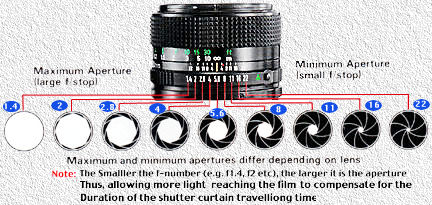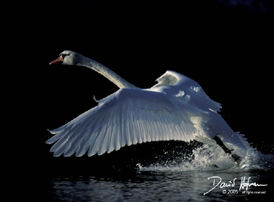In this case, it is not that confusing either, because it is actually quite simple where al the essentials can be concluded as a simple equation in Exposure = Aperture + Shutter Speed. To let you easier to digest what I said, an exposure can be interpreted in bare basic form - a developed image that can make you very happy about (minus the sentimental factor), other things like brilliance of colors, good contrast, well focus etc. - it is like things that simply make a cheerful day out of you...
What is an "aperture”?
Aperture is referred to the lens diaphragm opening inside a photographic lens. The size of the diaphragm opening in a camera lens REGULATES amount of light passes through onto the film inside the camera the moment when the shutter curtain in camera opens during an exposure process. The size of an aperture in a lens can either be a fixed or the most popular form in an adjustable type (like an SLR camera). Aperture size is usually calibrated in f-numbers or f-stops. I.e. those little numbers engraved on the lens barrel like f22 (f/22), 16 (f/16), f/11, f/8.0, f/5.6, f/4.0, f/2.8, f/2.0, f/1.8 etc. Each of this value represents one time the amount of light either more or less in quantity. Meaning to say, f/16 will let in 1X the amount of light than a diaphragm opening of f/22 and so forth; while on the other hand, an aperture of f/4.0 will let in 1X lesser than that of f/2.8 etc.
 Aperture also affects an important photographic element called "depth of field" (short form "DOF"). You may ask, what is hell is this "Depth of Field”? Depth of field is just technical term used to describe the 'zone' of sharpness' between nearest and furthest of a subject in focus (to be more exact, distance of sharp focus in front and behind, subject on which the lens is focused).
Aperture also affects an important photographic element called "depth of field" (short form "DOF"). You may ask, what is hell is this "Depth of Field”? Depth of field is just technical term used to describe the 'zone' of sharpness' between nearest and furthest of a subject in focus (to be more exact, distance of sharp focus in front and behind, subject on which the lens is focused).
The bigger the apertures used the zone of sharpness is shallower or vice versa i.e. smaller aperture used will have extended depth of field. For example: use larger aperture (Smaller number like f/2.8, f/2.0 etc.) with a long focal length to isolate or emphasis on expression, such as in portraiture photography; or use a smaller aperture (Bigger number like f/16 or f/22 etc...) to ensure pin-sharp details in both the foreground and the background.
What is shutter speed?
The aperture diaphragm of a lens (bigger or smaller values) AND timing (open and close) of the camera's shutter curtain - BOTH perform the tasks of regulating the amount of light entering the camera and expose onto the film. The shutter speed scales engraved on the shutter speed dial of conventional camera bodies with a shutter speed ring OR via some flickering digital numerals on the LCD screen like: 1/8000, 1/4000, 1/1000, 1/500, 1/250, 1/125, 1/60, 1/30, 1/15, 1/8, 1/4, 1/2, 1 or -1, -2 etc. are essentially indicators of the duration (timing) at which the shutter curtain opens up and closes during an exposure process. A 1/125 setting means the shutter curtain open and close within one hundred and twenty five of a second while 1 means a one full-second the shutter opens up during exposure to absorb the available light source onto the film to form an exposure.
Different selection of shutter speeds will yield different kind of visual effect on a final photograph. Generally, a fast shutter speed can freeze action while slow speed can blur your image. I am not indicating these are fixed rules. If you understand the nature of how various shutter speed(s) will affect an exposure, you may put them to creative use to enhance the effect - like other than freezing a fast action scene, a slow shutter speed can also put to good use in portraying movement. You can try on to "PAN" a moving subject by following its direction or simply generates a sense flow of movement. But MOST people relates SLOW means BLURRING AN IMAGE which leave little for them to select this alternative to try them out. Well, it is excusable because in most PR-type of photography (photo session on public relation matters like wedding, gathering, seminars, or personal domestic duties for some privileged group - includes your wife, mistress or girl friends..), who would appreciate a defocus or blurry images ? BUT - for the creative minded photographer, slower shutter speed sometimes may create a more powerful visual impact than images taken with action-freeze high shutter speed(s), say, a free flowing river, traffic, a flock of birds taking off or even speed-demons on a race track.. Etc.


What is an Exposure?It can be explained as the quantity of light allowed to act on a photographic material; a product of the intensity (controlled by the lens opening) and the duration (controlled by the shutter speed or enlarging time) of light striking the film or paper (darkroom or in the color-lab).
First, you MUST understand a fact, i.e. there is no such thing call a "perfect exposure". It is all a matter of personal preference - well, only the photographer who did the image captures process will "hold" the rights and judge whether it is or it is not a "good" exposure.
A short Summary:
Shutter speed(s) (Duration/timing of the shutter curtain closing inside the camera section): It controls the degree of movement in your pictures (fast speed to freeze a movement or slow speed to create creative motion effect).
Aperture(s) (lens section): It determines the depth of field (zone of sharpness in front and behind) of the focus subject of interest. It adds depth and dimension in your photos.
Exposure: Camera metering circuitry suggests an exposure (combination of shutter speed set in your camera + aperture selection on lens). User decides whether to override cameras metered / suggested combination for specific effect in the final image based on personal interpretation best expressing his/her thought.
It is so easy, isn't it?
2 comments:
what the hell is this?!! i dont wanna read about how u can take good pictures. i can read that in a book. write about yourself la!
haha...what u wanna know?
Post a Comment